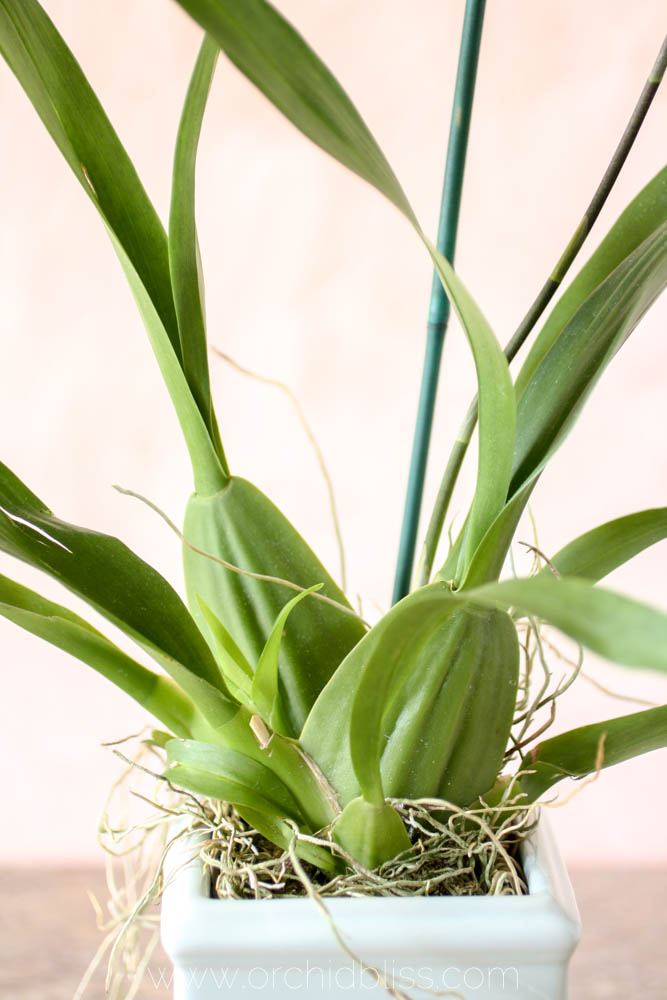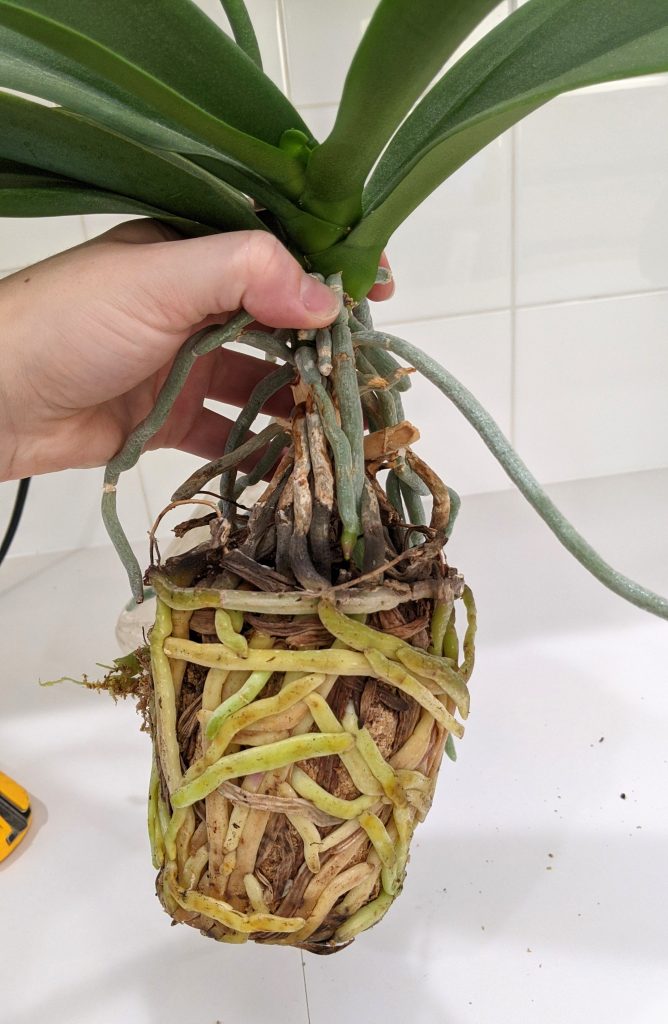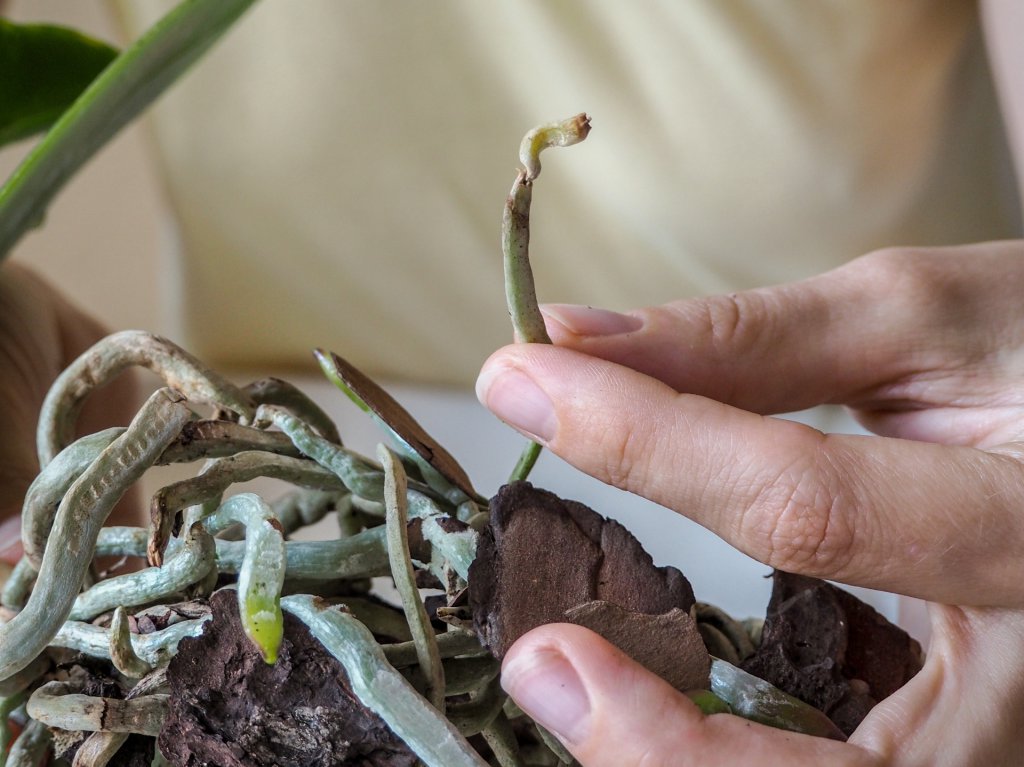Recognizing the Signs of Outgrowing
Orchid roots growing out of the pot is a common issue that many orchid enthusiasts face. It’s essential to recognize the signs of outgrowing to prevent root bound and ensure the continued health and well-being of the plant. One of the most obvious signs of outgrowing is when the roots start to grow out of the drainage holes in the pot. This can be a clear indication that the plant has outgrown its container and needs to be repotted. Another sign is when water starts to pool around the base of the plant, causing the roots to rot and the plant to become unstable. Additionally, if the plant becomes top-heavy and starts to lean or fall over, it may be a sign that the roots have outgrown the pot and need more room to expand.
Regularly inspecting the roots of the orchid can help identify any potential issues before they become major problems. Gently removing the plant from its pot and examining the roots can reveal any signs of outgrowing, such as circling or tangling roots. By recognizing these signs, orchid enthusiasts can take proactive steps to address the issue and prevent root bound.
It’s also important to note that different types of orchids have different growth habits, and some may be more prone to outgrowing their pots than others. For example, Phalaenopsis orchids are known to have a monopodial growth habit, which means they grow from a single stem and can produce long, trailing roots. These types of orchids may require more frequent repotting to accommodate their growing roots.
By being aware of the signs of outgrowing and taking regular action to inspect and maintain the roots of the orchid, enthusiasts can help prevent root bound and ensure the continued health and well-being of their plants.
Understanding Orchid Root Systems
Orchid roots are one of the most unique and fascinating aspects of these plants. Unlike other plants, orchids have evolved to produce aerial roots, which are adapted to absorb moisture and nutrients from the air. These roots are often thick and fleshy, and can be seen growing out of the pot or hanging down from the plant.
Orchids also have different growth habits, which can affect the way their roots grow. Monopodial orchids, such as Phalaenopsis, have a single stem that grows from the base of the plant, and can produce long, trailing roots. Sympodial orchids, such as Cattleya, have multiple stems that grow from the base of the plant, and can produce a more compact root system.
Providing adequate air circulation and moisture is crucial for healthy orchid root growth. Orchids need air to breathe, and their roots need moisture to absorb nutrients. A well-ventilated potting mix and a humid environment can help to promote healthy root growth and prevent root bound.
It’s also important to note that orchid roots are sensitive to over-watering, which can cause them to rot and die. Under-watering, on the other hand, can cause the roots to become dry and brittle. Finding the right balance of water and humidity is essential for promoting healthy root growth and preventing root bound.
By understanding the unique characteristics of orchid root systems, growers can take steps to provide the right conditions for healthy root growth. This includes using a well-ventilated potting mix, providing adequate air circulation and moisture, and avoiding over-watering. By doing so, growers can help to prevent root bound and promote healthy, thriving orchids.
How to Repot an Orchid with Outgrown Roots
Repotting an orchid with outgrown roots can be a delicate process, but with the right steps, you can give your plant the best chance to thrive. The first step is to choose the right potting mix. Look for a mix that is specifically designed for orchids and has good drainage, aeration, and moisture retention. Some popular potting mix options for orchids include sphagnum moss, perlite, and coconut husk.
Next, select a suitable pot size. The pot should be slightly larger than the previous one, but not so large that the roots become too spread out. A good rule of thumb is to choose a pot that is 1-2 sizes larger than the previous one.
Before repotting, gently remove the plant from its pot and examine the roots. If the roots are circling or tangling, gently tease them apart with your fingers or a blunt instrument. This will help to prevent root bound and promote healthy root growth.
Once the roots are prepared, place the plant in its new pot and add the potting mix. Make sure to leave enough space between the roots and the potting mix for proper air circulation and moisture retention. Water the plant thoroughly after repotting to settle the potting mix and provide enough moisture for the roots to establish themselves.
After repotting, provide your orchid with bright, indirect light and maintain a humid environment. This will help to promote healthy root growth and prevent root bound. With proper care and attention, your orchid should thrive in its new pot and continue to produce beautiful blooms.
Some common mistakes to avoid when repotting orchids include over-handling the roots, using too much potting mix, or not providing enough humidity during the transition period. By following these steps and avoiding common mistakes, you can give your orchid the best chance to thrive and enjoy its beautiful blooms for years to come.
Choosing the Right Potting Mix for Orchids
When it comes to choosing a potting mix for orchids, there are several key characteristics to look for. Good drainage, aeration, and moisture retention are essential for healthy root growth and preventing root bound. A well-suited potting mix should also be able to retain moisture but not waterlog the roots, as this can lead to root rot and other problems.
Some popular potting mix options for orchids include sphagnum moss, perlite, and coconut husk. Sphagnum moss is a popular choice for orchids because it retains moisture well and provides good aeration. Perlite is another good option, as it provides excellent drainage and aeration. Coconut husk is also a good choice, as it retains moisture well and provides a natural, sustainable option.
When selecting a potting mix, it’s also important to consider the specific needs of your orchid. Different types of orchids have different requirements, so it’s essential to choose a potting mix that meets the specific needs of your plant. For example, Phalaenopsis orchids prefer a potting mix with good moisture retention, while Cattleya orchids prefer a potting mix with good drainage.
In addition to the type of potting mix, it’s also important to consider the pH level. Orchids prefer a slightly acidic to neutral pH, ranging from 5.5 to 7.0. A potting mix with a pH level outside of this range can lead to nutrient deficiencies and other problems.
Some popular potting mix brands for orchids include Miracle-Gro, Black Gold, and Pro-Mix. These brands offer a range of potting mixes specifically designed for orchids, with different characteristics and ingredients to meet the specific needs of your plant.
By choosing the right potting mix for your orchid, you can provide the best possible conditions for healthy root growth and prevent root bound. Remember to consider the specific needs of your orchid, including the type of potting mix, pH level, and moisture retention, to ensure the best possible results.
Preventing Root Bound: Tips for Orchid Care
Preventing root bound is crucial for the health and well-being of your orchid. When an orchid’s roots outgrow its pot, it can lead to a range of problems, including reduced growth, decreased flowering, and increased susceptibility to disease. By taking a few simple steps, you can prevent root bound and give your orchid the best chance to thrive.
Regular repotting is one of the most effective ways to prevent root bound. Orchids typically need to be repotted every 1-3 years, depending on the type of orchid and the size of the pot. By repotting your orchid regularly, you can provide it with fresh potting mix and a larger pot, giving the roots room to grow and expand.
Providing sufficient light and water is also essential for preventing root bound. Orchids need bright, indirect light to photosynthesize and grow, and they need consistent moisture to keep the roots healthy. By providing your orchid with the right amount of light and water, you can promote healthy root growth and prevent root bound.
Fertilizing sparingly is also important for preventing root bound. Over-fertilizing can cause the roots to grow too quickly, leading to root bound and other problems. By fertilizing your orchid sparingly, you can promote healthy root growth and prevent root bound.
Monitoring your orchid’s roots is also crucial for preventing root bound. By regularly inspecting the roots, you can identify any potential problems before they become major issues. If you notice that the roots are growing out of the pot or becoming circling, it may be time to repot your orchid.
By following these tips, you can prevent root bound and give your orchid the best chance to thrive. Remember to repot your orchid regularly, provide sufficient light and water, fertilize sparingly, and monitor the roots regularly to prevent root bound and promote healthy growth.
Common Mistakes to Avoid When Repotting Orchids
Repotting an orchid can be a delicate process, and there are several common mistakes to avoid to ensure the health and well-being of your plant. One of the most common mistakes is over-handling the roots. Orchid roots are sensitive and can be easily damaged, so it’s essential to handle them gently and carefully during the repotting process.
Using too much potting mix is another common mistake to avoid. Orchids prefer to be slightly root-bound, so using too much potting mix can cause the roots to become waterlogged and lead to root rot. It’s essential to use the right amount of potting mix and to gently firm it around the roots to prevent settling.
Not providing enough humidity during the transition period is also a common mistake to avoid. Orchids prefer high humidity, especially during the repotting process. By providing enough humidity, you can help to reduce stress and promote healthy growth.
Repotting an orchid at the wrong time is also a common mistake to avoid. Orchids typically need to be repotted every 1-3 years, depending on the type of orchid and the size of the pot. By repotting your orchid at the right time, you can provide it with fresh potting mix and a larger pot, giving the roots room to grow and expand.
Finally, not monitoring the orchid’s roots after repotting is a common mistake to avoid. By regularly inspecting the roots, you can identify any potential problems before they become major issues. If you notice that the roots are growing out of the pot or becoming circling, it may be time to repot your orchid again.
By avoiding these common mistakes, you can ensure the health and well-being of your orchid and provide it with the best chance to thrive. Remember to handle the roots gently, use the right amount of potting mix, provide enough humidity, repot at the right time, and monitor the roots regularly to prevent root bound and promote healthy growth.
Orchid Potting Mixes: A Comparison of Popular Brands
When it comes to choosing the right potting mix for orchids, there are several popular brands to consider. Each brand has its unique characteristics, pros, and cons, which can make it challenging to decide which one to use. In this article, we will compare and contrast some of the most popular orchid potting mix brands to help you make an informed decision.
One of the most popular potting mix brands for orchids is Miracle-Gro. Their Orchid Potting Mix is specifically designed to provide good drainage, aeration, and moisture retention, making it an excellent choice for orchid enthusiasts. However, some users have reported that it can be too dense and may cause water to pool around the roots.
Another popular brand is Black Gold. Their Orchid Mix is a blend of natural ingredients, including peat moss, perlite, and vermiculite, which provides excellent drainage and aeration. It is also pH-balanced, making it suitable for most orchid species. However, some users have reported that it can be too dry and may require more frequent watering.
Repotme is a popular choice among orchid enthusiasts, and their potting mix is specifically designed to meet the unique needs of orchids. It is a blend of sphagnum moss, perlite, and vermiculite, which provides excellent moisture retention and aeration. However, some users have reported that it can be too expensive compared to other brands.
Pro-Mix is a well-known brand in the horticulture industry, and their Orchid Mix is a popular choice among orchid enthusiasts. It is a blend of peat moss, perlite, and vermiculite, which provides excellent drainage and aeration. It is also pH-balanced, making it suitable for most orchid species. However, some users have reported that it can be too dense and may cause water to pool around the roots.
When choosing a potting mix for your orchid, it is essential to consider the specific needs of your plant. If you have an orchid with aerial roots, you may want to consider a potting mix that provides excellent moisture retention, such as Repotme. If you have an orchid that prefers well-draining soil, you may want to consider a potting mix like Black Gold.
In conclusion, the best potting mix for your orchid will depend on the specific needs of your plant. By considering the pros and cons of each brand, you can make an informed decision and provide your orchid with the best chance to thrive. Remember, when orchid roots growing out of the pot, it’s essential to repot your orchid in a well-draining potting mix to prevent root bound and ensure healthy growth.
Conclusion: Giving Your Orchid the Best Chance to Thrive
Addressing outgrown roots in orchids is a crucial step in providing the best possible care for these beautiful plants. When orchid roots growing out of the pot, it’s essential to take action to prevent root bound and ensure healthy growth. By recognizing the signs of outgrowing, understanding the unique characteristics of orchid root systems, and following the steps outlined in this article, you can give your orchid the best chance to thrive.
Remember, repotting an orchid with outgrown roots requires careful handling and attention to detail. Choosing the right potting mix, selecting a suitable pot size, and gently handling the roots during the repotting process are all critical steps in ensuring the health and well-being of your orchid.
In addition to repotting, regular care and maintenance are essential for preventing root bound and promoting healthy growth. Providing sufficient light and water, fertilizing sparingly, and pruning dead or damaged roots can all help to keep your orchid happy and thriving.
By following the tips and guidelines outlined in this article, you can help to prevent root bound and ensure that your orchid continues to grow and flourish. Whether you’re a seasoned orchid enthusiast or just starting out, with the right care and attention, you can enjoy the beauty and elegance of these stunning plants for years to come.
Don’t let outgrown roots hold your orchid back. Take action today and give your plant the best chance to thrive. With a little care and attention, you can enjoy the beauty and wonder of orchids for years to come.








